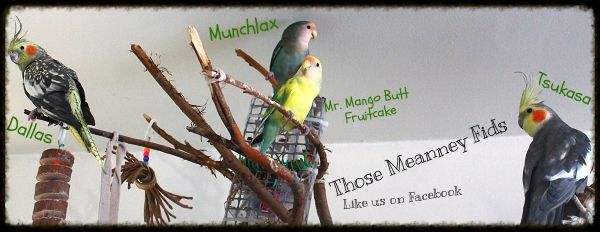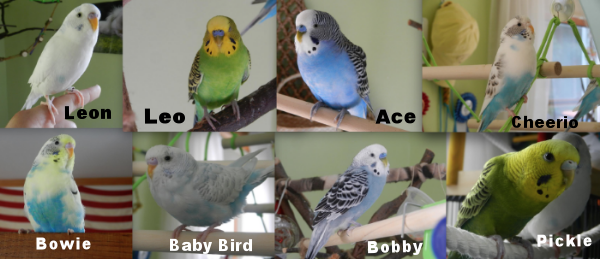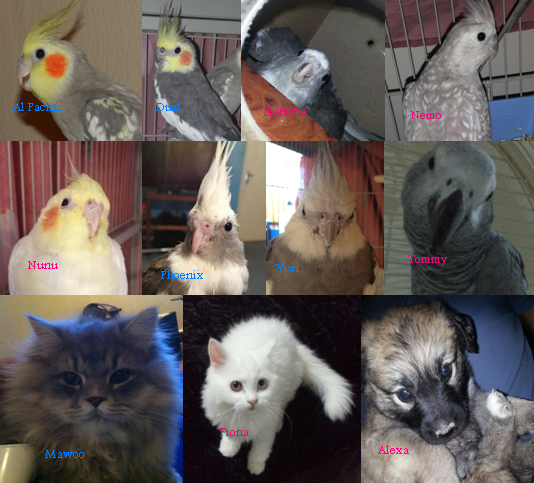Post by Annie on Apr 9, 2012 4:42:06 GMT -8
;D(condensed and abridged from the article "Does a Parrot Enjoy Companion Life?" by Mattie Sue Athan from Parrot Life, issue 2, 05;
When feeling worried about the adequacy of care provided to our parrots, responsible owners can look for behaviours indicating health and comfort. While many well adjusted parrots will exhibit some or many of these behaviors, not all birds display all of the following activities:
1) Vocalization: Most avian vocalizations, whether singing, talking, or simply unintelligible chatter obviously indicate the feelings of well-being we humans associate with happiness.
2) Preening: A healthy parrot keeps its feathers in order, but a bird that does little except preen may be experiencing boredom or failure of independence.
3) Bathing: Most parrots relish showers or bathing in a bowl; many of them enjoy daily bathing. A bird that does not take an occasional head dip into a clean water bowl may not be feeling well.
4) Stretching: A happy, satisfied parrot will stretch in several different ways (wing and leg together on both sides of the body and raising both shoulders).
5) Flapping: Many companion birds like to hold on tight to the cage or perch and flap their wings.
6) Tail Wagging: When a healthy, happy parrot is anticipating a different activity, it may wag its tail feathers vigorously. This behaviour resembles a giggle in humans. It indicates that the bird is ready to proceed to the next activity.
7) Beak Grinding: A sleepy parrot grinding the upper and lower beaks together with eyes closed or nearly closed is showing contentment.
8) The Fluff Up or Rough Out: Temporarily ruffled feathers by a parrot that is not in a drafty environment or exhibiting concurrent signs of illness demonstrates well-being, interest, or contentment. This behavior is often accompanied by a tail wag or even a brief whole body shake.
9) Sleeping on One Foot: A healthy, well-balanced bird usually pulls one foot up under the belly feathers when sleeping.
10) Toy Play: Parrots enjoy having the luxury of play behaviours even as adults.
11) Tongue Wiggling or Tactile Use of the Tongue: Tongue wiggling can be an invitation to pet. The tongue is a sensory organ in a parrot, and a parrot that allows petting of the tongue is usually enjoying a happy interchange.
12) Beak Wiping: Although a parrot might wipe its beak off on a perch or cage accessory after eating, it's an expression of happiness relating to that which is being wiped, whether it's a perch or person.
13) Pinpointing or Eye Flashing: A quick narrowing of the pupil, causing the iris to enlarge, indicates interest or excitement by a healthy parrot.
14) Dancing or Head Bobbing: A dancing, head bobbing parrot is usually expressing energy and well-being. Head bobbing behaviour may escalate to courtship or sexual behavior.
15) Leaning or "Begging": A parrot flattening itself and leaning toward something or someone is expressing a desire for that object or person.
16) Flying or Following: A bird that is willing to follow you around the house on wing or on foot is either delighted with your company or stalking you, but either way is an indication of a self-confident, healthy avian.
17) Beak "Chattering": Tongue wiggling in cockatoos and some other parrots is often accompanied by a rapid up and down movement of the upper beak. This behavior is a clear happiness behavior, although a few mischievous birds might use it as a solicitation to pet, then bite for the fun of it.
18) Tapping: Tapping with foot or beak against a perch, wall, toy or human is a signal or a territorial display and an indication of well-being.
19) Sexual Motivation: While biting and other territorial behaviors might accompany sexual displays and masturbation, these are usually an indication of a healthy, happy bird.
A sick or maladjusted bird will engage in few or none of the behaviours mentoned above. If you are concerned that your bird isn't demonstrating a sense of well-being, take it immediately to an avian veterinarian.
When feeling worried about the adequacy of care provided to our parrots, responsible owners can look for behaviours indicating health and comfort. While many well adjusted parrots will exhibit some or many of these behaviors, not all birds display all of the following activities:
1) Vocalization: Most avian vocalizations, whether singing, talking, or simply unintelligible chatter obviously indicate the feelings of well-being we humans associate with happiness.
2) Preening: A healthy parrot keeps its feathers in order, but a bird that does little except preen may be experiencing boredom or failure of independence.
3) Bathing: Most parrots relish showers or bathing in a bowl; many of them enjoy daily bathing. A bird that does not take an occasional head dip into a clean water bowl may not be feeling well.
4) Stretching: A happy, satisfied parrot will stretch in several different ways (wing and leg together on both sides of the body and raising both shoulders).
5) Flapping: Many companion birds like to hold on tight to the cage or perch and flap their wings.
6) Tail Wagging: When a healthy, happy parrot is anticipating a different activity, it may wag its tail feathers vigorously. This behaviour resembles a giggle in humans. It indicates that the bird is ready to proceed to the next activity.
7) Beak Grinding: A sleepy parrot grinding the upper and lower beaks together with eyes closed or nearly closed is showing contentment.
8) The Fluff Up or Rough Out: Temporarily ruffled feathers by a parrot that is not in a drafty environment or exhibiting concurrent signs of illness demonstrates well-being, interest, or contentment. This behavior is often accompanied by a tail wag or even a brief whole body shake.
9) Sleeping on One Foot: A healthy, well-balanced bird usually pulls one foot up under the belly feathers when sleeping.
10) Toy Play: Parrots enjoy having the luxury of play behaviours even as adults.
11) Tongue Wiggling or Tactile Use of the Tongue: Tongue wiggling can be an invitation to pet. The tongue is a sensory organ in a parrot, and a parrot that allows petting of the tongue is usually enjoying a happy interchange.
12) Beak Wiping: Although a parrot might wipe its beak off on a perch or cage accessory after eating, it's an expression of happiness relating to that which is being wiped, whether it's a perch or person.
13) Pinpointing or Eye Flashing: A quick narrowing of the pupil, causing the iris to enlarge, indicates interest or excitement by a healthy parrot.
14) Dancing or Head Bobbing: A dancing, head bobbing parrot is usually expressing energy and well-being. Head bobbing behaviour may escalate to courtship or sexual behavior.
15) Leaning or "Begging": A parrot flattening itself and leaning toward something or someone is expressing a desire for that object or person.
16) Flying or Following: A bird that is willing to follow you around the house on wing or on foot is either delighted with your company or stalking you, but either way is an indication of a self-confident, healthy avian.
17) Beak "Chattering": Tongue wiggling in cockatoos and some other parrots is often accompanied by a rapid up and down movement of the upper beak. This behavior is a clear happiness behavior, although a few mischievous birds might use it as a solicitation to pet, then bite for the fun of it.
18) Tapping: Tapping with foot or beak against a perch, wall, toy or human is a signal or a territorial display and an indication of well-being.
19) Sexual Motivation: While biting and other territorial behaviors might accompany sexual displays and masturbation, these are usually an indication of a healthy, happy bird.
A sick or maladjusted bird will engage in few or none of the behaviours mentoned above. If you are concerned that your bird isn't demonstrating a sense of well-being, take it immediately to an avian veterinarian.













 ), tongue wiggling and tapping. I'm convinced she's ecstatic
), tongue wiggling and tapping. I'm convinced she's ecstatic  but I guess not every parrot will do every single thing on the list!
but I guess not every parrot will do every single thing on the list!